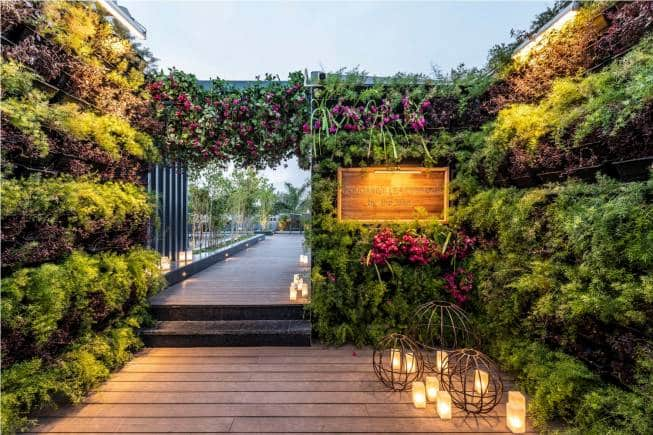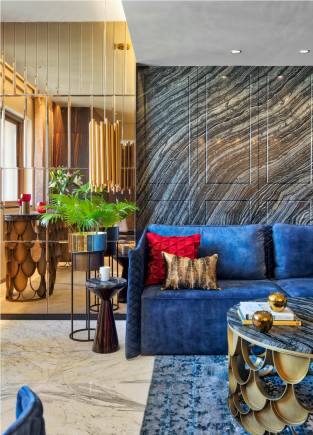



How blessed we are to finally get our noses and mouths freed from masks? This liberation is to be cherished as the world gets more familiar with Covid and feels less anxious about it. So it’s not surprising that design trends 2023 are now influenced by renewed appreciation for happiness and wellness… with a grateful nod to nature and a special mention of the arts.
Hello, nature
What’s gaining traction is Biophilic design, a term coined by German social psychologist and humanistic philosopher Erich Fromm for “passionate love of life and of all that is alive… whether in a person, a plant, an idea, or a social group.” Scientists and philosophers later translated it to an innate desire in humans, as part of the evolutionary process, to connect to nature, in their settings, within the home and outside.
 Green walls are appealing to the eyes and good for our souls (Photo courtesy Studio Design Inc)
Green walls are appealing to the eyes and good for our souls (Photo courtesy Studio Design Inc)
According to a paper on Biophilic design: 14 Patterns of Biophilic Design, Improving Health & Well-Being in the Built Environment, supported by US-based sustainability consulting firm Terrapin Bright Green, “Empirical studies have reported that experiences of natural environments provide greater emotional restoration, with lower instances of tension, anxiety, anger, fatigue, confusion and total mood disturbance than urban environments with limited characteristics of nature.”
Minnie Bhatt, founder, Minnie Bhatt Design, Mumbai, too says she feels a need to experiment more with Biophilic design and sees the trend continuing through the year.
Amazon’s headquarters, The Spheres, in Seattle, USA, gives tangible form to Biophilic design. Three giant glass spheres are virtual greenhouses seamlessly integrated into an urban environment with multilevel botanical gardens and more than 40,000 plants from the cloud forest regions of over 30 countries, some of them extinct in the wild. The living walls of the globes have more than 25,000 plants woven into 4,000 square feet of mesh, giving Amazon employees an up, close and personal connect to nature.
 Outdoor area with central tree courtesy Minnie Bhatt Design
Outdoor area with central tree courtesy Minnie Bhatt Design
Another marvel is The Bosco Verticale, two residential towers in Milan, Italy. Plants and shrubs cover most of the balconies and walls of the buildings and these are maintained by harvested rainwater. Water features, natural light and greenery enhance the feeling of wellbeing.
The paper on Biophilic design, which has also been co-authored by Terrapin Bright Green founding partner William Browning, a green building and real estate industry thinker and strategist plus an advocate for sustainable design solutions, also says that a visual connection with nature can result in lowered blood pressure and heart rate, improved mental engagement and attentiveness as well as positively impacted attitude and overall happiness.
Interior aesthetics
So what’s happening inside homes? Bhatt says, “Interiors have moved from minimalism to maximalism and tropical aesthetics. Tropical modern will be a continuing trend for the future.”
 Make art a part of your life Courtesy Studio Design Inc
Make art a part of your life Courtesy Studio Design Inc
Design will also include holistic spaces with strong defining characteristics reflecting the personality of the users even while steering away from cookie cutter design, says Khandelwal.
You don't need a cash stash or a big dacha to embrace holistic living that translates to stress free existence focused on the bigger picture called life. You can set up a corner in your tiny home with your Tibetan singing bowls and candles, thinking and focusing clearly in open spaces with minimal clutter, feeling pleased about the neatly labelled mixed seed containers (for breakfast) snug in their allocated shelf in the kitchen.
Reimagining walls
In walls, Khandelwal sees a movement in terms of structure, texture, materials, and forms. The materials used may be local and conventional, but these are being reimagined for a more contemporary approach, she says.
 The focus is on art pieces and scultpures courtesy Minnie Bhatt Design
The focus is on art pieces and scultpures courtesy Minnie Bhatt Design
Simple brick will do the trick, or repurposed wood or brass, or even veneers that are now coming in numerous patterns and textures to create impressive wall finishes. “Stones and marbles, too, are being used to create distinct shapes and patterns wherein technology has been a key medium that has aided in pioneering these unique wall textures and finishes,” Khandelwal adds.
Bhatt bats for stone too. Designers are “also going in for natural finishes like paint textures, wallpapers, perforated or other decorative bricks,” she says.
Celebrating art
This is also a time to show off all the art you are holding on to and celebrate the skills of crafts persons and their fascinating past. You have to just imagine the conversation around a bronze Swamimalai icon, for instance. The icons are created by the artisan community known as Sthapathis who are said to be descendants of sculptors contracted by Raja Raja Chola 1, ruler of the Chola Empire (985 and 1014 AD) to build the Brihadisvara Temple in Thanjavur. They settled later in Swamimalai, now Tamil Nadu.
Also, even if you have displayed your Warlis, Bidriware, or Aranmula Kannadis, give a shout out to the ancient (some say 4,000 years old) Dhokra metal craft from West Bengal, Chhattisgarh, Madhya Pradesh and Odisha (craftsmanship can differ from state to state).
Named after the Dhokra Damar Tribes, the traditional metal smiths of West Bengal, these art pieces – Human forms, birds and animals – in bell metal, bronze and brass, are made using a unique metal casting and wax technique that can be traced back to the Indus Valley Civilisation and is likely to have been used to create the Dancing Girl of Mohenjo-daro. Popular folklore credits the discovery of this technique to a gentleman who, while witnessing a forest fire, observed beeswax falling on an anthill and taking on a beautiful shape. He realised it was great for making moulds.
Local art and craft point to a “shift” says Khandelwal, mainly seen in the extensive use of terracotta, Longpi (pottery from Manipur), brass etc which was earlier used only for pots, and is now being used to create timeless sculptures, vases, totems, and so on.
“Now we are leaning towards indigenous arts and crafts when it comes to artwork for interior spaces. Local artisanal work is being explored and repurposed and infused into modern sculptures and decor. There is a subsequent rise and appreciation for the use of regional materials for an earthy appeal,” she says.
Art installations and sculptures will be the way forward, Bhatt says. “These can be in the form of lights or totems.”
Furniture and furnishings
Regional and local elements will also be favoured for furniture and furnishings, Khandelwal predicts. “There will be a considerable surge in the use of handmade pieces and a need will be felt to implement regional art forms into it.”
So, local materials such as cane, stones and terrazzo will be used to create contemporary furniture.
In furnishings, she is all for a neutral palette with woven textures. “These are soft, made from natural linen, weaves, dyes, etc, which produce a variety of textures.”
Bhatt says furniture choices will include a blend of two materials and not all wood – Like terrazzo and wood as a combination or concrete and wood etc.
Furnishings will include chenille, linen fabrics and also velvets and pure or faux leather, she adds. Vibrant prints will replace plain fabrics.
 From stones to soft furnishings, design trends are all about minimalism versus maximalism. (Photo courtesy Studio Design Inc)
From stones to soft furnishings, design trends are all about minimalism versus maximalism. (Photo courtesy Studio Design Inc)
Things to remember
For Khandelwal, when designing outdoors or landscapes, the significant factor that should be considered is the climate or the weather of the place. These elements can be a dominating aspect when deciding on the design of the landscape. Additionally, materials and functionality should be the key considerations for creating outdoor spaces with just the right ambience and mood.
Bhatt feels there should be a sense of timelessness about the look and feel of spaces – interiors and outdoors. There should be longevity and durability not only in terms of how the materials wear out but also in terms of aesthetics.
A quick makeover?
Bhatt says a quick makeover for summer would be to introduce bright and happy prints in upholstery materials. In winter it would be light and bright upholstery prints and colours that carry on to tables and floor lamps to “cheer up the space.”
Discover the latest Business News, Sensex, and Nifty updates. Obtain Personal Finance insights, tax queries, and expert opinions on Moneycontrol or download the Moneycontrol App to stay updated!
Find the best of Al News in one place, specially curated for you every weekend.
Stay on top of the latest tech trends and biggest startup news.